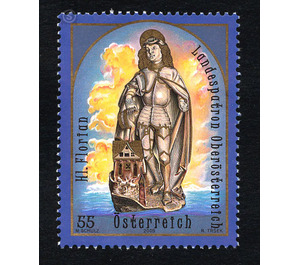patrons - Austria / II. Republic of Austria 2005 - 55 Euro Cent
Theme: Religion & Spirituality
| Country | Austria / II. Republic of Austria |
| Issue Date | 2005 |
| Face Value | 55.00 |
| Edition Issued | 1,000,000 |
| Printing Type | combination printing |
| Stamp Type | Commemorative |
| Item Type | Stamp |
| Chronological Issue Number | 1870 |
| Chronological Chapter | OOS-OE2 |
| SID | 941824 |
| In 55 Wishlists | |
Saint Florian is the only martyr known by name in Austria. The vernacular reports that the boy Florian once miraculously extinguished a house fire with a single small bucket of water. This story spread quickly in the people and so Florian was called for help towards the end of the Middle Ages in fires. The saints were given the attributes fire, house, water bucket or jug on the representations that were created at the same time. He is the most revered saint in Upper Austria and patron saint of fire brigades, potters, blacksmiths, chimney sweeps, soap makers and beer brewers. On his 1700th anniversary of his death, the secret patron saint of St. Florian's Basilica was also officially named patron saint of Upper Austria. During the reign of the Emperor Diocletian and Maximian extensive Christian persecution were ordered, including in today's territory of Austria. Saint Florian, born about 250, was a high Roman civil servant who had converted to Christianity. One day the Roman governor Aquilinus of Lauriacum in the province of Ufernorikum (Lorch in Upper Austria) attacked 40 Christians. Florian immediately arrived from Aelium Cetium, now St. Pölten, to help, but was himself arrested as a Christian. In spite of all the tortures, he stubbornly refused to give up his faith and sacrifice again to the Roman gods, and was sentenced to death. On May 4, 304, the sentence was enforced. After shattering his shoulder blades with sharp irons, he was thrown into the river with a millstone around his neck from the Enns Bridge. According to legend, the soldier who had pushed him remained blind all his life and the river waves are said to have buried the corpse on a rock protruding from the water. Thereupon an eagle is said to have floated down, guarding the corpse of the saint. Florian appeared to a devout widow and asked her to look for him and bury him in a certain place. The woman immediately got up and buried the corpse and buried it in the designated place. Many miracles and healings took place in this place and the tomb became a place of pilgrimage. Later, the monastery basilica of St. Florian was built on this site.


